
Author: Rachel Malamud
Scenes from the Latin Quarter/Opera/Rent
After reading Scenes of a Latin Quarter, I was intrigued to read more of it. The reading was not as dense as I expected it to be, and the mini plots within each chapter were enjoyable. Scenes of a Latin Quarter explored the typical life that bohemians experience. It consists of pursuing creative aspirations with a lack of money and complicated romantic relationships. For example, the first charterer introduced to readers is Alexander Schaunard, and he faces the problem of paying the debt he owes for rent. Furthermore, the relationship between Mademoiselle Mimi and Rodolphe the poet explored how heartbreak and deceitfulness hinders an artists’ creativity. While Rodolphe was stuck in a slump, he wrote about the absence of Mimi’s white hands and the departure of his youth and future. Contrastly, Mimi did not love Rodolphe and she was using him for attention and money. The bohemic impoverished lifestyle is not a simple task, but rather a risqué adventure that requires an artist to sacrifice and dive all in for their true passion.
Listening to the opera lecture was not my favorite part because by the end of it, I had a slight headache. Learning about a brief history of opera in Western classical music, with a focus on Europe and the United States, was slightly compelling. The developments that have been made allowed for new themes to be explored in the work of art. The transition from mythology and religious themes to the common emotions of “normal” townsfolk made opera more personable. While I was listening to the opera clips, I noticed that the high-pitched, screeching voice of female singers was not enjoyable for me. The male singers were easier to listen to, but overall it was hard to comprehend some of the songs. The facial expressions helped to carry the message, but it would have been better to actually see an opera.
Watching the movie Rent was a good conclusion to the lesson. It portrayed the story of a group of bohemians who struggled to express themselves through their art and “measuring their lives in love.” The setting was New York East village and it highlighted the extra challenges, like poverty and the AIDS epidemic, that artists had to face. Within the movie, there was a songwriter, a filmmaker, a dancer, a performance artist, a lawyer, and a philosophy professor. Most of the characters were exploring relationships, and the addition of homosexuality made it more relevant to today. Also, the constant battle to pursue your art with no money or sell your soul for some cash was prevalent through the filmmaker character. This rock opera had a few catchy songs, but I rather hear a normal conversation than someone singing.
Punk Rock – Rich Stremme
When I found out that a guest speaker was going to talk to us, I was interested to know what aspect of art they will be discussing. The options, however, did not really appeal to me: DIY, punk rock, graffiti, tattoos, or poetry. The class settled on punk rock and I was willing to listen to what the guest speaker had to say.
The guest speaker, Rich Stremme, presented some highlights of his creative background and took us through a trip down memory lane. Stremme mentioned that his interest in punk rock started young at the age of eleven. He did not know much about this kind of music before because his musical background consisted of whatever was played on the radio. Stremme started writing a zine called Socially Unaccepted in middle school, and discovered the similar roots between reggae music and punk rock. Eventually, he formed his own band, Brutally Familiar, and went around touring on a national level. His anecdote about a show in El Paso, Texas where kids were border hopping to see his band perform shocked me. It put into perspective the recognition that I did not know punk rock artists received. This incident was the inspiration behind his band’s album Ashamed to be White. Stremme pointed out that punk rock is predominantly a male genre, and the few females that engaged with it were most likely photographers or in the background of crowds. I was not too surprised by this statement.
Rich Stremme dabbled with different artistic mediums, and his work with Revs inspired him to graffiti his story in New York City train tunnels. Ian Mackaye said that “punk rock is free space”, and Stremme added on to that idea by saying “if you did it first, you did it best.” Punk rock, especially in America, was different from traditional British punk because artists were considered “dangerous” if they dressed like average looking people and blended in. It was cool to see some actual 7 inch records and get a “vintage” pin and sticker, but by the end of the presentation, I was not persuaded to listen to punk rock music on my own time. Stremme emphasized that punk rock is not meant to exclude anyone, but it is one of those things where you either like it or you don’t. The natural divide happens because of how different the genre is from what is considered traditional.

Graffiti/Street Art

New Perspective on “The Woman Who Gave Birth to Rabbits”
After listening to “The Woman Who Gave Birth to Rabbits”, by Stephen Garcia, my biggest takeaway was that reading and watching a play provides different interpretations of the plot.
Upon first glance, I noticed how strange the title was. How did she give birth to rabbits? Why rabbits and not another animal? When I was reading the play at my own pace, I marked up some quotes that stood out to me because they seemed relevant to that character’s development. I also took note of the recurring themes, such as gender roles and superior vs. inferior. In the margins, I commented on the characters’ behaviors and emotions. This may have been excessive and tedious, but it helped me understand the message of the play and I actually enjoyed reading it.
A couple of days before the live reading, I was discussing the play with a few peers and the general interpretation was that rabbits were chosen to symbolize fertility and Mary Toft, the wife, gave birth to rabbits as a punishment for Joshua Toft’s, the husband, actions and misdirected prayers. It was a bit disappointing to hear from Stephen Garcia that the play is based on a true 18th century event. I thought it was just a very strange play with an absurd plot that seemed to work well and make for an interesting read. Regardless, the actors read the characters in the way that I envisioned it and their body language and facial expressions portrayed the emotion of the character very well.
It was cool to be able to ask questions, and when I asked my question about the significance behind the whiskey for the character Thomas Ahlers, Joshua’s best friend, I didn’t get the answer I expected. I interpreted the whiskey as Thomas’ method of releasing the palpable tension, but the actor Gil viewed it as a minute detail. Whiskey was the common drink of the 18th century, so that could be the reason why Thomas was consistently drinking and offering it to others. A discussion point that stuck out to me was the concept of money and making the arts more accessible. Stephen Garcia mentioned how his plays used to be free, but now he has to charge a price because assigning a value to one’s work makes it more respectable in society’s eyes. The play may be $5, but $5 versus free says something about the artist’s work. He also briefly brought up Broadway and the high ticket prices, but I actually disagreed with him on this because if the play was able to make it to the level of Broadway, then that means it’s worth the price and accessibility is not the main concern.
At the end of day, I finally got to see the Macaulay building and I was able to hear a live reading for free.
Night at the Museum: Not the Movie Experience
When I first heard we had a “Night at the Museum” trip, I immediately thought it was going to be like the movie where a T-Rex skeleton comes to life, but then I realized that stuff is impossible to be a reality. There may not have been any talking statues or Robin Williams as Teddy Roosevelt, but I still had an interesting time at the Brooklyn Museum.
For starters, I was excited to go because I didn’t have any classes that day and a coach bus was bringing us there. I was ready to be immersed in the artwork and I got the chance to check off another museum I haven’t been to before. When we arrived, I was shocked by the architecture of the museum and thought to myself, “Well if the outside looks this cool, then inside it will be just the same, if not better.” As I sat in the auditorium with over 500 people and listened to the provost speak in a very philosophical manner, I found myself indeed agreeing with his interpretation of what is a museum. It truly is a place where culture is in conversation with itself, and it was proven to me as I explored the different exhibits.


Straight out of the auditorium, I noticed abstract and geometric patterns along the walls. Something about them was appealing to just stop and stare at them for some time. They were satisfying to look at, but they weren’t the abstraction that defined Picasso’s art, which I really enjoy analyzing. Contrastly, the Assyrian art that followed did not speak to me, to the point where I just glanced side to side and ended up at the end of the hallway without realizing. History is not my thing, so when I see it infused in art, I don’t really give it a second look. At the end of the hallway was a “perfect time” for a mini photo session of Macaulay CSI, and the mini groups we formed made the rest of the experience fun.
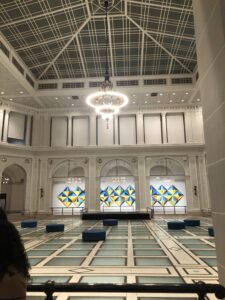

Afterwards, some of us went to the 5th floor where it was less crowded, and I could tell there was going to be something here that I would actually like looking at. The first thing that stuck out to me was this work called “Bring a Folding Chair: A Portrait of Shirley Chisholm”. Obviously, I did not touch it, but it was very tempting because I could tell there was a lot of texture to the work. The folding chairs on the skirt was something new and I didn’t understand it until I read Shirley Chisholm’s quote: “If they don’t give you a seat at the table, bring a folding chair.” The way I interpreted this was that if you’re not welcomed somewhere, carve out your own place and prove why you should be there. There were also a lot of oil paintings and I was able to connect what we talked about in the seminar to what I was seeing. There were paintings of fruit and landscapes, but also a blue wall covered in flowers and a painting of Virgin Mary surrounded by fruit.
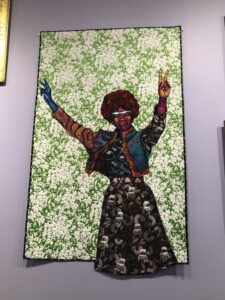


The last stop for me was the storage room, where I saw a lot of furniture, specifically chairs, and some old paintings. The chairs did not look the most comfortable and I didn’t understand why they were placed in a museum. The one thing from the storage room that I liked was this lamp that had a cover similar to the roses and vase in Beauty and the Beast. Overall, I had a good time on the trip and now I can say that I have had my own Night at the Museum experience.
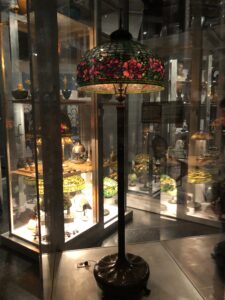
Banksy: An Artistic Criminal
For this independent trip, I decided to go to the Banksy Museum mainly because I was not familiar with who Banksy is or his artwork. From the discussions in class, I sensed that he is an anonymous artist who does graffiti on the walls of popular cities. I was interested in checking it out and when I left the museum, I was more appalled than satisfied by what I saw.
Upon entering the museum, I saw one of Banksy’s works that seemed to have some contradicting elements. The work is titled “The Mild Mild West” and it was one of Banksy’s first murals. The title is a play on the words “the wild wild west”, which I picked up on quickly, but I was distracted by the teddy bear holding a Molotov cocktail. It was aiming to throw at the approaching riot police officers dressed in black. How could a sweet, innocent children’s toy be turned into such a violent person with no expression to its actions? To say that this is the mild west is an understatement. Banksy used irony to portray the theme of non-conformity, which is a concept society is familiar with, but the approach taken was not for me.
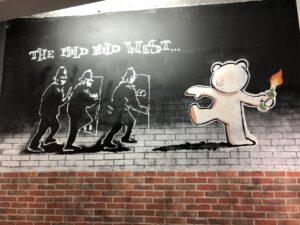
I continued following the blue arrows directing me where to look next, and at every turn, I saw another piece of “artwork” that exaggerated its message. For example, the piece titled “Toxic Mary” angered me because the point Banksy was attempting to convey was not the common consensus. In the piece, the Virgin Mary is holding a baby and is feeding it a bottle of poison rather than milk. Banksy wanted to show how the influence of caregivers can be toxic and that a child has no control over how their life will turn out. I strongly disagreed with Banksy’s view because the role of caregivers and parents is to protect, guide, and love the child. No one is out to harm the child, and while they may have no control in the early stages of development, it is not accurate to say that they are on a fixed path they cannot get off of.

Within this small museum, I would say there was a handful of hypocritical artwork that stood out to me. One of those was titled “Snorting Copper”, highlighting how even law enforcement breaks the rules they are suppose to enforce. The cop’s eyes reflect his guilty conscience and fear of being caught. Another one was titled “Grannies”, emphasizing how compassionate the older generation is towards youth’s rebellious ideas. Typically, the older someone gets, the more conservative they are in their actions, but these grannies seem to be still living out their good old days.


I cannot say that I was displeased with the experience entirely. There were some funny works of art, such as “Aachoo! (Old Woman Sneezing)” and “Hula-Hoop Girl”, but that did not hide what Banksy’s true mission is with his art. Most of the art had a very judgemental perspective, whether it be portraying the weaknesses of government officials as apes or adding in a weapon/firearm to an innocent children like drawing. Would I call Banksy’s work art? No. There was not a lot that I agreed with and the more I saw, the quicker I wanted to leave the museum. Personally, I do not understand the fascination with someone who promotes false beliefs or propaganda, but to each their one.


The Counter Review
The Counter was severely underestimated initially, but I left with a new point of view about the expected vs. unexpected of life. One of the main points throughout the play was that Paul, the lead male role, wanted to experience a surprise in his life because he was too numb and comfortable with the life he has been living. The emotional and physical exhaustion he was left with after taking care of and losing his mother and brother had become unbearable. After experiencing so much grief, Paul’s life became predictable and he wanted to gain back at least an ounce of control. To him, the solution was a radical approach, specifically deciding the way he would die but not when he would go. He transferred partial control to Katie, the female lead role, to gain the surprise element he was missing in life. As a result, the audience was left in suspense, wondering when she would add the poison to the coffee and if she would even do it.
While Paul was playing with his life and letting it hang in someone else’s hands, Katie was frantically going through the motions of her so-called “give up life” or escape fantasy. On the surface, she appeared satisfied with her quaint little life working as a diner waitress in a small town. Deep down, she was nitpicking month-old voicemails and contemplating if her past actions justified the life she has now. She was pulled into quite a situation when she agreed to be friends with Paul and share secrets or tough talks. Little did she know that Paul would be criticizing her life and implying that she was not familiar with the concept of having to take care of someone. The immediate level of aggression from Katie’s voice shocked the audience. Her explanation of her obstacles, such as having to give up the option of children, indicated that she knows what it means to be selfish if it means taking care of yourself.
The repetition of the counter scene emphasized that having the same daily routine could provide a sense of balance, but it could also become mundane. Every morning, Paul would come into the diner and Katie would pour him a cup of coffee. This interaction is what opens the door to the friendship that they develop throughout the play. Had it not been for those tough talks, Paul might have never started to learn Italian and Katie would not have deleted any voicemails. Both characters would have missed out on what the world was offering them, and they needed that extra nudge out the door to remind them that there is a meaning to life and it becomes much warmer when surrounded by friends.
Political Art
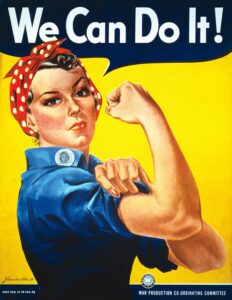
The political art that I have chosen is of Rosie the Riveter saying “We Can Do It!”. The context behind the art is that it encouraged women to work in factories and shipyards during World War II while men were serving. It was uncommon to see a woman working a job and being outside the house not doing housework such as cleaning, cooking, etc. This poster stood as a source of inspiration to women who believed societal standards and listened to the ingrained beliefs in their head telling them they cannot do anything more. Seeing a woman with a serious face and muscles while also wearing makeup and being put together proved to the public that women can balance their lifestyles. They can be both feminine and masculine in proportion and there is nothing wrong with that. This poster was important because it highlighted that there is no cookie cutter or perfect mold of how a woman should be or act. It was a pivotal piece of artwork that pushed women outside of their comfort zones. Today, this picture of Rosie the Riveter still resonates with people, especially with women who want to work in a predominantly male industry. There will always be a disparity between men’s abilities and women’s abilities, but having artwork like this reminds society that women are just as capable, if not more, of doing the same thing as men. The next time a company wants to hire a man for a leadership role, maybe they should consider the woman instead of eliminating her from the running immediately.
A Strange Trip to the Guggenheim
My experience at the Solomon R. Guggenheim Museum was not what I expected. I first researched the museum and saw it has twentieth-century modern and contemporary art. Truthfully, I do not know what that entails, but I assumed there would be some pretty landscape paintings I could look at and take a picture of. I could have chosen the common options of the MOMA, the Rubin, or the Whitney, but I wanted to visit a museum that many of my peers did not go to and discover something new.
Upon entering the museum, the first thing I noticed was the architecture of the building, which was more interesting than some of the displays and exhibits. From the outside, it looks like a rotunda, and inside of the museum, there was a spiral ramp rising to a domed skylight. Immediately, I noticed the words circling the ramp, and I felt uncomfortable by some of the phrases. The display, titled Light Line, was something the museum wanted the public to notice because it addresses modern-day political division over women’s rights, the violence of war, climate justice, etc. “The words invite thinking on biases and beliefs; the work is a challenge to power abused.” I understand how the words are implicitly fighting against abused power, but I experienced more discomfort and tension than discovering a new perspective. I realized that this display was meant to showcase how every aspect of our life is either being controlled, watched, or both. The question is who is pulling the strings and why do we as a society continue to let them dictate our lives? My main takeaway from this display was that life should be approached with caution because your actions are a source of information for someone else, like the government who is always listening and watching.

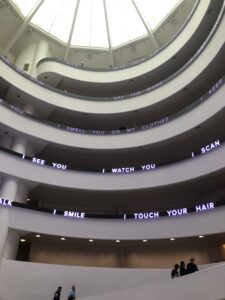
As I made my way up the ramp, I saw some oil paintings that provided a sense of peace and serenity when I looked at them. There were paintings of fruit and landscapes, and I was able to connect them to our discussion in class about Berger’s views on oil paintings. Some can argue that they were pained for monetary value, but at the time the painting was created, the artist could have been implying a message with their choice of subject. It’s up to us to decipher that message and offer a new perspective to art that was created over 100 years ago. What really excited me was that I saw paintings created by Vincent Van Gogh and Pablo Picasso. I’m familiar with these artists, so it’s always intriguing to see their other works that are not as common. It was good to have that change in emotion from disturbing to tranquility.
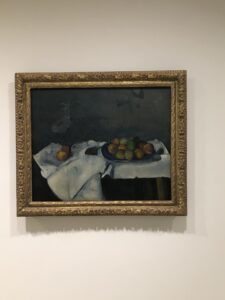
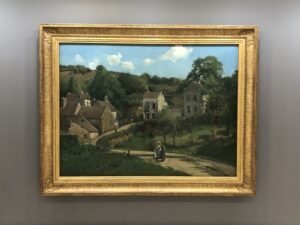
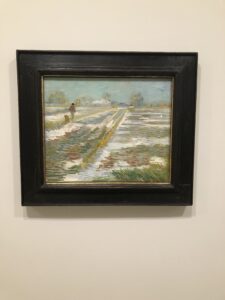
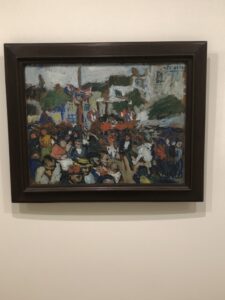
The exhibit that stood out to me the most was a four-wall display of former President Donald J. Trump’s tweets engraved on metal sheets. The metal sheets were arranged chronologically, starting with his tweets from the beginning of his presidency in January 2017. On the last wall, the metal sheets started to curve downwards and there was a pile of them on the floor. I took the time to read each tweet to understand Trump’s views when he was in office, and I found myself alternating between agreeing and disagreeing with his statements. The metal sheets on the floor were dated 2020, indicating the end of his presidency. This display was a political message conveying that his words were being censored and ignored by the time his presidency ended. I found it more interesting how a large number of people also stopped and read every tweet, regardless if they agreed or disagreed with his views.

Overall, this museum portrayed its exhibits in either a political, confusing, or vulgar manner. There was not that much art that I enjoyed looking at, but the select ones that I found were the ones that I spent more time analyzing and reading the attached blurb.

